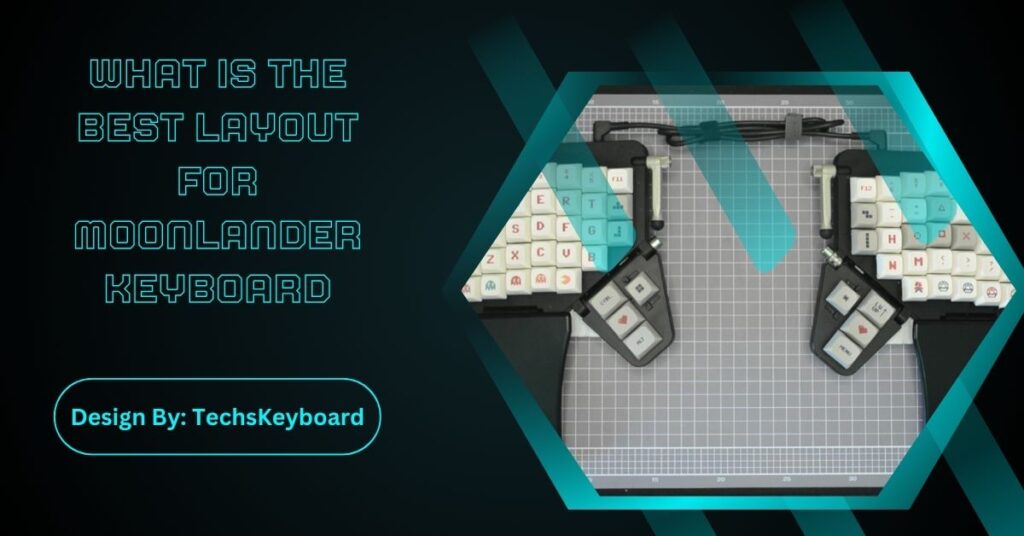The best Moonlander keyboard layout depends on your needs. Colemak optimizes comfort, Dvorak enhances typing efficiency, and QWERTY ensures simplicity. The Moonlander’s customizable design supports all layouts effortlessly.
The Moonlander Keyboard stands out as a game-changer in the world of ergonomic keyboards. With its split design, adjustable tenting angles, and highly customizable features, it’s a treasure for typing enthusiasts and productivity geeks.
But one key question lingers for new and experienced users alike—what is the best layout for the Moonlander Keyboard? Let’s break it down.
Introduction to the Moonlander Keyboard:
The Moonlander Keyboard by ZSA is a fully split, ergonomic mechanical keyboard designed with comfort and customization in mind. Unlike traditional keyboards, the Moonlander offers flexibility in both its physical design and programmable keys, allowing users to optimize for posture, typing efficiency, and personal preferences. It’s no wonder that it’s a go-to tool for many coders, writers, and gamers.
Key Features:
- Split design for ergonomic typing
- Adjustable tenting angles for wrist comfort
- Fully programmable keys
- High-quality mechanical switches
Importance of Keyboard Layouts:

A well-chosen keyboard layout can significantly impact your typing speed, accuracy, and overall comfort. Whether you’re an experienced touch typist or someone looking to improve your typing habits, selecting the right layout is essential.
Here’s Why:
- Typing Speed: The layout determines how quickly you can type and access keys.
- Ergonomics: Certain layouts reduce finger movement, decreasing strain on your hands and wrists.
- Productivity: A good layout minimizes errors and improves workflow in day-to-day usage.
Choosing the optimal layout is especially critical on a platform as customizable as the Moonlander.
Popular Keyboard Layouts:
Each keyboard layout has unique characteristics. The most commonly used layouts are:
QWERTY
- Pros: Universally known; familiar to most users.
- Cons: Designed for typewriters, it’s not optimized for ergonomic typing or speed.
- Best For: Beginners and those who don’t want to deal with a learning curve.
Colemak
- Pros: Reduces finger movement compared to QWERTY; promotes faster typing and better ergonomics.
- Cons: Requires a slight learning curve.
- Best For: Users seeking a balance between speed and comfort without a drastic change.
Dvorak
- Pros: Designed for maximum speed and efficiency; minimizes movements by placing commonly used keys under your fingers.
- Cons: Steeper learning curve; harder to find pre-configured keyboard support.
- Best For: Typing enthusiasts and those prioritizing maximum efficiency.
Best Layout for the Moonlander Keyboard:
The Moonlander’s unique design provides a significant advantage—it works well with all layouts. However, users often find certain layouts more beneficial due to its ergonomic features.
Why does Colemak shine on Moonlander?
- With its reduced finger movement and optimized key positioning, Colemak pairs perfectly with the Moonlander’s programmable key setup.
- The layout takes full advantage of the split design, greatly minimizing hand strain during long typing sessions.
Dvorak for Power Users
For those willing to invest time to adapt, Dvorak’s focus on efficiency makes it a strong contender for use on the Moonlander. Its layout pairs beautifully with the ergonomic split design, ensuring minimal finger travel.
QWERTY for Simplicity
For users who prefer traditional layouts, QWERTY still works harmoniously on the Moonlander, particularly due to its adjustability and comfort-focused features. It’s a great fallback for those who want functionality without the adjustment period.
Also Read: How To Paste With Keyboard – A Step-by-Step Guide!
Customization Options:
What sets the Moonlander apart is its programmable keys. You can redefine every key’s function, create macros, or even implement layers for specific tasks like coding or gaming.
Key Customization Features:
- Programmable Layers for task-specific layouts
- Key Remapping to switch keys around for better comfort
- Tenting and Tilting to set the perfect typing angle
This means you don’t need to adhere strictly to traditional layouts—you can customize any layout to better suit your needs!
User Testimonials:
Real Experiences from Moonlander Users:
- Anna S. (Colemak User): “Switching to Colemak on the Moonlander has completely transformed my workflow. The reduced finger movement combined with the comfortable split design cut my wrist pain in half!”
- Jason P. (Dvorak User): “I’m a coder, so I customized Dvorak on the Moonlander with separate layers just for shortcuts. It’s a game-changer for productivity.”
- Sarah L. (QWERTY User): “I stuck with QWERTY but added some macros for my work in Excel. Even without transitioning layouts, this keyboard is the most comfortable I’ve ever used.”
Compatibility and Connectivity:

The Moonlander keyboard is designed to work seamlessly with various devices and operating systems. Whether you’re using Windows, macOS, or Linux, the keyboard’s compatibility ensures a smooth connection experience. Additionally, it supports both wired and wireless configurations, offering flexibility for different setups.
Ergonomic Design:
Ergonomics is at the heart of the Moonlander’s design. The keyboard’s split layout allows users to position each half comfortably, reducing strain on the shoulders and wrists. Coupled with customizable tenting and tilting options, it promotes a healthier typing posture, making it ideal for long typing sessions.
Software and Firmware Updates:
The Moonlander is powered by cutting-edge software, continually updated to enhance user experience. With ongoing firmware updates, users can enjoy new features and improvements, ensuring the keyboard remains future-proof and reliable over time. Additionally, the open-source software allows for community contributions and customization options.
FAQs:
1. What makes the Moonlander Keyboard unique?
The Moonlander’s split design, adjustable tenting angles, and fully programmable keys provide unparalleled ergonomic comfort and customization, making it ideal for coders, writers, and productivity enthusiasts.
2. Which layout is best for typing speed on Moonlander?
Dvorak is designed for maximum typing speed and efficiency, placing frequently used keys under your fingers, minimizing movement, and pairing well with the Moonlander’s ergonomic split design.
3. Can I use QWERTY on the Moonlander Keyboard?
Yes, QWERTY works perfectly with the Moonlander. Its adjustability and ergonomic features enhance comfort while maintaining familiarity, making it a great choice for users who prefer traditional layouts.
4. Why is Colemak recommended for Moonlander?
Colemak reduces finger movement and optimizes key placement, complementing the Moonlander’s split design. It provides excellent ergonomics and improved typing speed with a manageable learning curve.
5. What customization options does the Moonlander offer?
The Moonlander allows key remapping, programmable layers, and macro creation. Its tenting and tilting features enable perfect ergonomic adjustments, tailoring the keyboard to your specific typing and workflow needs.
Conclusion:
The Moonlander Keyboard is a versatile ergonomic tool that adapts to any layout, from QWERTY’s simplicity to Colemak’s comfort and Dvorak’s efficiency. Its split design, adjustable angles, and extensive customization options make it ideal for users seeking to enhance typing comfort and productivity. Whether you prioritize traditional layouts or advanced configurations, the Moonlander empowers you to personalize your typing experience, ensuring a healthier, more efficient, and satisfying workflow.


